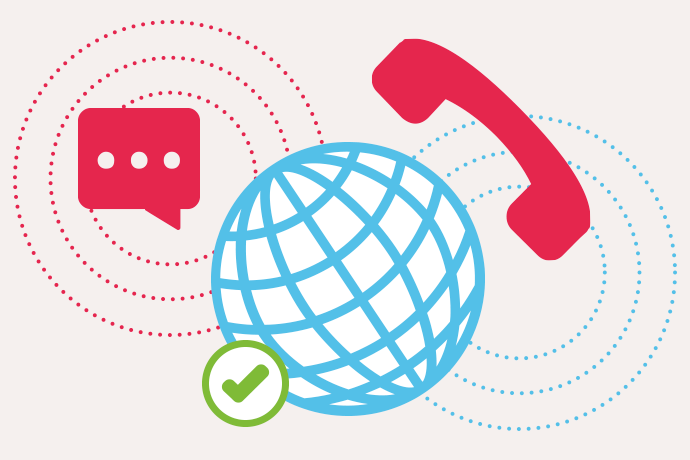Cart Total
$0.00
-
Your shopping cart is empty
Loading

Hello! Log in Your Account
New customer? Start here


|
5 min read
Contents
Quick Summary
Examining the differences between VoIP and PSTN communications solutions and VoIP benefits.
As you know, running a business involves making smart decisions for budget and growth potential - and choosing the right phone system is paramount to this. It’s key for you to understand the different options available to you to choose the right option for your business specifically.
The Public Switched Telephone Network (PSTN) is the traditional landline system run over copper wires, while Voice over Internet Protocol (VoIP) is a newer, Internet-based system which is often deployed in the Cloud.
The PSTN is what traditional landlines use to make calls. You likely have one in your home, or in the office if you have a traditional desk phone. It is sometimes referred to as POTS, or ‘Plain Old Telephone System’. It uses a vast network of wires to transmit your voice as an audio signal, and there are exchange buildings in different locations needed to operate this system.
On the other hand, VoIP is a system that uses the Internet, or an ethernet connection, to convert your voice into ‘digital data packets’. These then travel across the Internet and are ‘reassembled’ at the other end for the recipient to hear.
There are a few factors that you need to take into consideration when deciding which option to choose for your business.
Perhaps the most important consideration is that the PSTN is being switched off by BT completely by 2027. This means that while you may not want to switch right now, everyone will eventually be pushed to do so; even your Nan’s house phone will be on VoIP, so it’s best to get with the program now and stay ahead of the curve! This will help you avoid unnecessary complications at the last minute, and give you time to become a VoIP whizz by the time BT switches off the PSTN for good.
This being said, let’s take a look at the benefits of both options:
| Benefits | VoIP | PSTN |
| Costs | VoIP solutions are often supplied on a predictable month-by-month basis for manageable billing, with less chance of surprise fees. | PSTN is charged on a per-minute basis, which makes it difficult to manage costs, especially in businesses.There are also additional charges for long distance calling and ‘tack-on’ features. |
| Flexibility and scalability | With VoIP it is easy to add users, work remotely from almost any smart device with an internet connection, and integrate with other tools you already use day-to-day. | PSTN lines have limited features and require physical phone lines. This restricts remote work, and can be expensive to set up new users and departments. |
| Reliability | The idea that VoIP is more unreliable than PSTN is not true, especially with Yay.com. We are load-balanced, while using the latest technologies and best CODECS for a reliable and high quality calling experience. | PSTN is not limited to internet connection, and so is often reliable, however quality can be lowered by damage to phone lines or hardware issues. |
| Numbering options | You have a wide choice of numbers to choose from, including local, non-geographic, and even international numbers, no matter where you are based in the world. | With PSTN you are limited to local numbers and often allocated numbers based on your physical location which offers very little customisation. |
| Call features | VoIP solutions offer features such as messaging, hold music, voicemail transcriptions and even video calling, so that all communications solutions are all under one roof. | With PSTN features are very limited, and will offer a basic call functionality which can seem dated to your callers, making it hard to get the information they want quickly. |
While PSTN has been the standard for almost 150 years, VoIP is becoming an increasingly favoured choice due to its cost-effectiveness, additional features and flexibility. It’s something you should consider for your business, especially as eventually everyone will have to make the switch after the PSTN switch-off. Keeping ahead of the curve, getting things in place now and training staff to use VoIP before 2027 will set you ahead of the competition and position your business for success.
Now that you have a better understanding of your options, you can weigh the pros and cons to choose the system that will best suit your business needs both now and in the future.
If you want to learn more about Yay.com’s business phone system and how we can help, or even if you are still unsure and would like to chat, please get in touch! We can help you make an informed decision and choose the right phone system plan for your business.


Explore how Skype's end-of-life announcement presents an opportunity for small businesses to upgrade their Skype number to a VoIP phone system.
Posted March 10 2025 | 6 min

Everything you need to consider when moving offices, from hardware to call quality.
Posted January 16 2025 | 6 min

Corded headsets vs wireless headsets? Learn about the key considerations when purchasing a VoIP headset for your VoIP phone system and softphone apps.
Revised December 3 2024 | 9 min

VoIP is incredibly well suited to being the phone system for businesses of all sizes. Large businesses in particular can benefit from great scalability, bulk-deployment options and more.
Revised August 21 2024 | 8 min

Get your business up to speed before the PSTN and ISDN switch off in 2027. Discover what digital VoIP technologies will mean for business landlines in the future.
Revised July 15 2024 | 6 min

With the upcoming switch from PSTN to VoIP, we look at what processes other countries have taken when they decided to migrate their own copper line networks.
Posted August 1 2023 | 6 min

VoIP apps or VoIP desk phones, which is better and why? We discuss how VoIP desk phones could be obsolete with the availability of greater and more powerful VoIP apps .
Revised November 2 2022 | 7 min

Cloud VoIP phone systems offer key advantages for businesses. Here are 13 of VoIP's key benefits that have helped to drive the adoption of business VoIP.
Revised May 10 2022 | 12 min

How cost-effective is VoIP? Is VoIP secure? How fast does my Internet need to be? We answer these questions and more.
Posted January 11 2022 | 5 min

VoIP won't work without the internet, but that doesn't mean you need a wired broadband connection. A supplemental mobile cellular data network (4G, 5G, LTE) can make VoIP calls possible even if broadband is unavailable.
Posted January 11 2022 | 5 min

Offer great customer service, but do so efficiently. Automate aspects of your phone system and provide self-service information to free staff resources.
Posted September 24 2021 | 4 min

Call recording is a feature of good VoIP phone systems that allows customers to record their business calls, then playback and download them.
Posted September 17 2021 | 6 min

Large corporations have requirements that surpass the capabilities of most phone systems. With Yay.com build your ideal business phone system effortlessly.
Revised August 25 2021 | 5 min

A good business phone system will help you run day-to-day operations more efficiently and effectively. Here are 5 ways yours can improve customer satisfaction.
Posted August 19 2021 | 4 min

Features like call parking and shortcodes can boost the efficiency of your business phone system, saving your teams time.
Posted August 18 2021 | 6 min

Learn what VoIP 'QoS' or Quality of Service is and why your business network needs it configured for the best VoIP experience.
Posted March 9 2021 | 3 min

With Yay.com's free VoIP trial you can try business VoIP for free for fourteen days - no credit card required. Enjoy all of our powerful business phone system features at no cost.
Posted December 3 2020 | 4 min

Business VoIP makes it possible to work from anywhere. We'll get you up and running for working from home, no matter whether you prefer VoIP desk phones or VoIP apps.
Posted November 12 2020 | 3 min